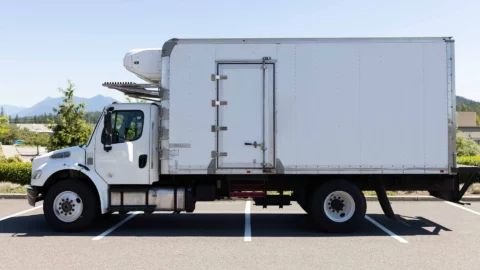The ABCs of Outbound Logistics

Brief Introduction to Outbound Logistics
From the very moment a product rolls off the production line to its final destination at the customer's doorstep, every step on its journey refers to outbound logistics. Described as the process of managing and overseeing the movement of goods from a company's storage or production facilities to the end consumer, it plays a pivotal role in ensuring that products reach their final destination efficiently and effectively. By orchestrating the movement of goods through coordination and synchronization, outbound logistics connects businesses to their customers while shaping customer satisfaction and building a solid brand reputation.
Beyond a simple transfer of products, outbound logistics is a complex, strategic, and meticulous process, including warehousing, transportation, last-mile delivery, and even reverse logistics. The efficiency of each step is a linchpin, directly influencing customer satisfaction and loyalty, thus elevating outbound logistics to a crucial position in the global supply chain. It takes center stage, providing the vital link between production and consumption, creating a seamless and memorable customer experience, and reinforcing the bond between businesses and their clientele.
Key Components of Outbound Logistics
To comprehend the symphony of outbound logistics, let's embark on a journey through its essential components:
Warehousing
Once produced, a product needs a safe and secure place to be stored for a potential purchase. It can be either your own warehouse or one provided by a third-party logistics company. Improper warehousing logistics and management can lead to product damage, which, in turn, may result in significant financial losses.
Transportation
Whether by land, sea, or air, each mode of transportation introduces a delicate balance between cost, speed, and reliability. The logistics conductor must decide which notes to emphasize, optimizing the transport mix to create a dynamic and efficient score. Just as a composer carefully selects instruments for a symphony, a logistics manager must orchestrate transportation methods that resonate with the specific needs of the supply chain.
Storage
Not all products move to the customer directly from a manufacturing facility. As a rule of thumb, they first deliver to logistics hubs or distribution centers for pre-sell storage. It is essential to ensure efficient inventory to minimize delays and enhance accessibility. Strategically placed and organized storage may dramatically cut final delivery times and costs, shaping a positive customer experience and cementing brand loyalty.
Last-Mile Delivery
The final step of the delivery process, last-mile delivery, is often a customer’s only direct interaction with the logistics process. During this interaction, the delivery process transforms into either a positive or negative customer experience, making or breaking your brand reputation. Precision and efficiency of last-mile delivery are especially paramount, leaving an indelible mark on customer satisfaction.
Like instruments in an orchestra, outbound logistics components, including warehousing, transportation, storage, and last-mile delivery, must harmonize. The efficiency of each element influences the others, creating a collective impact on the successful delivery of products to the end customer. Thus, improper storage and delays in transportation may disrupt the last-mile delivery rhythm, affecting customer satisfaction. Conversely, inefficient last-mile delivery can not only ruin customer loyalty to the brand but also lead to unwanted financial losses and reverse logistics. Understanding this delicate dance between these components is crucial to orchestrating a logistical masterpiece that resonates with both businesses and customers alike.
Challenges in Outbound Logistics
Despite the meticulous planning, outbound logistics is accompanied by many challenges. Thus, route inefficiencies, traffic congestion, and adverse weather conditions may cause delivery delays, increase costs, and affect customer satisfaction.
Whether caused by unexpected bottlenecks, logistical hiccups, or unforeseen circumstances, delays can have a cascading effect on the entire supply chain. Customers, accustomed to the immediacy of modern commerce, can become frustrated when promised delivery times are not met. This challenge requires a delicate balancing act – meeting customer expectations while navigating the unpredictable variables often accompanying the journey from warehouse to doorstep.
Route inefficiencies present another obstacle in the outbound logistics landscape. Planning the most optimal routes for product delivery is akin to charting a course through a labyrinth. The complexities of road networks, traffic patterns, and varying modes of transportation introduce a level of intricacy that demands sophisticated solutions. An inefficient route increases operational costs and prolongs delivery times, exacerbating the challenge of meeting customer expectations.
Maintaining customer satisfaction in the face of these challenges becomes a high-stakes endeavor. Armed with many choices, customers are quick to shift allegiance if their experience falls short. The challenge lies not only in ensuring that products reach their destination but also in doing so seamlessly, leaving a positive, lasting impression. This necessitates a holistic approach to outbound logistics that goes beyond the physical movement of goods to encompass the entire customer journey.
The complexities associated with traffic congestion and adverse weather conditions add layers of difficulty to outbound logistics. Picture a congested highway or a snow-covered route; these external factors can significantly impede the timely movement of goods. Traffic jams and inclement weather are unpredictable variables that logistics managers must contend with, requiring contingency plans to mitigate their impact. These challenges highlight the need for adaptability in outbound logistics, where navigating unforeseen circumstances becomes a crucial skill.
Prompt and reliable service, the cornerstone of successful outbound logistics, is often easier said than done. Customers, expecting a seamless and dependable experience, demand nothing less than excellence. Achieving this requires precise planning and an intricate web of communication and collaboration with all stakeholders in the supply chain. Real-time visibility into the logistics process becomes imperative, allowing for proactive problem-solving and informed decision-making.

Solutions to Outbound Logistics Challenges
In the face of challenges, businesses must be armed with different strategies and solutions to ensure a seamless and efficient supply chain. Running the gamut from route optimization and weather monitoring to improved communication and collaboration with logistics partners, they go beyond merely addressing issues, transforming challenges into opportunities for optimization and improvement.
Route Optimization:
Non-stop route optimization is a valuable strategic approach that uses technology to chart the most efficient course for product delivery. Advanced software and data analytics enable logistics managers to navigate the complex web of road networks and transportation modes. By optimizing routes, businesses not only reduce operational costs but also minimize delivery times, contributing to the overall satisfaction of end consumers.
Weather Monitoring:
Weather monitoring systems provide real-time data on atmospheric conditions, allowing logistics managers to anticipate and plan for adverse weather events. Armed with this information, businesses can adjust routes, reschedule deliveries, or implement contingency plans to mitigate the impact of inclement weather. By staying one step ahead, companies can enhance the reliability of their service and minimize disruptions caused by unpredictable meteorological factors.
Enhanced Communication:
Effective communication is the glue that holds the various components of outbound logistics together. Internally, transparent and timely communication within the organization ensures that all departments are aligned with logistics objectives. Externally, communication with customers becomes a crucial aspect of managing expectations. Providing real-time updates on the status of deliveries, potential delays, and any relevant information creates transparency and fosters trust.
Collaboration with Logistics Partners:
By forming strong alliances with carriers, warehouses, and other key players in the supply chain, businesses can create a resilient network that adapts to challenges seamlessly. Collaborative efforts ensure everyone is working towards a common goal, sharing insights, resources, and expertise. The collective strength of a collaborative network enhances the overall efficiency of outbound logistics, turning challenges into shared victories.
In the pursuit of efficient outbound logistics, these solutions work in tandem, creating a holistic approach to address challenges comprehensively. Route optimization sets the foundation, weather monitoring provides foresight, enhanced communication builds trust, and collaboration with logistics partners forms a united front against challenges. Together, they form a robust strategy that not only mitigates the impact of challenges but elevates outbound logistics to a level of operational excellence.
Streamlining Outbound Logistics with Expedite All
Perpetually encountering new challenges in outbound logistics, businesses are on a non-stop quest for innovative solutions to streamline their operations. In this quest, Expedite All emerges as a beacon of efficiency, providing practical tools to revolutionize the way companies approach outbound logistics. Its innovative solutions transcend the traditional boundaries of logistics management, offering a comprehensive suite of features designed to address the nuanced challenges faced by businesses in the complex realm of supply chain operations.
Expedite All stands as a testament to the power of technology in enhancing outbound logistics. At its core, it is a game-changer, providing businesses with real-time tracking capabilities that offer unprecedented visibility into the movement of goods. This feature empowers logistics managers with up-to-the-minute information and allows for proactive decision-making, ensuring that potential disruptions are identified and addressed before they escalate. Moreover, Expedite All's route optimization acts as a logistical compass, dynamically adjusting routes in response to real-time data. This helps minimize delays and maximize efficiency, reducing operational costs and improving the overall speed of product delivery.
Expedite All goes beyond mere functionality, creating a seamless logistics experience. It connects you with reliable carriers to ensure that every phase of the logistics journey is entrusted to partners renowned for their unwavering reliability. From timely deliveries to efficient handling, its commitment to excellence is ingrained in every aspect of your logistics operations, providing you with peace of mind and a truly dependable service.
On a Final Note
Outbound logistics stands as the linchpin in the intricate process of product delivery, wielding a critical influence on both timeliness and customer satisfaction. Navigating the challenges inherent in this domain is paramount, demanding a proactive approach and strategic implementation of optimized logistics practices. Addressing bottlenecks and streamlining the outbound logistics chain not only averts potential disruptions but also enhances overall operational efficiency. To this end, businesses should explore innovative solutions to propel their logistics endeavors forward. One such solution is Expedite All, a cutting-edge tool poised to revolutionize outbound logistics. Expedite All promises to mitigate logistical complexities by leveraging advanced technology, ensuring swifter and more reliable product deliveries. As businesses increasingly recognize the pivotal role of outbound logistics, embracing solutions like Expedite All becomes integral to fostering a seamless and customer-centric supply chain.


